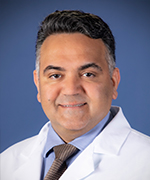Minimally Invasive Colorectal Surgery
At UC Davis, our expert surgeons use minimally invasive colorectal surgical techniques whenever possible. With a smaller incision and less disruption to your intestines, you can expect to recover in just a few days as well as a quicker return to everyday activities.
If you need colorectal surgery, it is only natural to worry if and when you'll feel more like yourself again. In fact, some people try to avoid having surgery, fearing they may lose their ability to have a normal bowel movement. We're committed to using the least invasive but most effective techniques to help preserve healthy tissue.
Minimally Invasive Colorectal Surgery at UC Davis: Why Choose Us?
As the only academic medical center in the Sacramento area, we offer significant advantages when it comes to minimally invasive colorectal surgery.
Highlights of our program include:
- Expertise: Our dedicated colorectal surgeons are recognized experts. In addition to pioneering laparoscopic surgical techniques through prestigious research efforts, we train other surgeons on minimally invasive techniques for colorectal surgery. Meet our team.
- Experience: Our surgeons have more than 20 years of experience with laparoscopic techniques. They use the latest minimally invasive tools and technology such as robotic surgery to ensure precision and safety during surgery. This experience means that you receive superior care and treatment that gives you the best chance for a successful outcome.
- Comprehensive follow-up care: We understand that comprehensive follow-up care is critical to a successful recovery. Our surgeons, nurses and other specialists provide thorough follow-up care that includes education on how to transition home and appointments to check in on your health after surgery.
Minimally Invasive Colorectal Surgery Techniques
At UC Davis, we are a regional leader in minimally invasive colorectal surgery, offering the latest and most invasive minimally invasive surgical procedures, including:
- Laparoscopic surgery: After placing several small incisions near the surgical area, we insert special instruments and a tiny camera (laparoscope) attached to long rods. The camera sends live video to a monitor. The instruments work as extensions of the surgeon's hands to carry out your procedure. Learn more about laparoscopic procedures.
- Robotic surgery: We insert instruments and a camera through tiny incisions, and the surgeon uses a computer system (robot) to perform your procedure. Robotic surgery allows a range of motion that is not possible through other methods and allows for precise movements in hard to reach areas. Read our robotic surgery FAQs.
- Transanal minimally invasive surgery (TAMIS): TAMIS is a technique that helps us remove difficult pre-cancerous growths (polyps) and tumors in the rectum and lower part of the colon. TAMIS uses laparoscopic tools we insert through the anus to view the surgical area and remove (excise) the polyp or tumor.
- Transanal total mesorectal excision (TaTME): TaTME is similar to TAMIS in that we access the surgical area through the anus. Using minimally invasive techniques, such as laparoscopic and robotic surgery, we approach polyps or tumors from two angles instead of one. This approach allows us to quickly and completely remove polyps and tumors in difficult to reach areas.
Minimally Invasive Colorectal Procedures
Many procedures can be performed with minimally invasive techniques. The procedure that is best for you depends on the reason you need surgery and your previous medical history, as well as your personal preferences. In rare cases, a traditional, open surgery might be best. We work with you to help you understand your options and select the procedure that will best meet your needs.
Minimally invasive colorectal procedures available at UC Davis include:
- IIleal pouch anal anastomosis (IPAA): When the entire colon and rectum needs to be removed, IPAA can help preserve normal bowel functioning. IPAA works by sewing the healthy end of your small bowel directly to the anus. We use the small intestine tissue to create a pouch to collect stool until you eliminate it through a bowel movement. Learn about sphincter-sparing minimally invasive surgery.
- Colostomy: A colostomy connects the open end of your colon to the abdomen. Instead of having a bowel movement, you pass stool into a special bag worn outside your body. A colostomy can bring changes to your everyday life, but we help you get back to your favorite activities over time. Learn more about preparing for surgery, including special support for colostomy patients.
- Ileostomy: An ileostomy connects the open end of the small intestine to the abdomen. Instead of having a bowel movement, you pass stool into a special bag worn outside your body. An ileostomy can bring changes to your everyday life but we help you to get back to your favorite activities over time.
- Resection: During a resection, we remove the diseased portion of the digestive tract. Our colorectal surgeons take special care to remove the smallest necessary amount of tissue, which helps you maintain normal digestive functioning after surgery.
- Stricturoplasty: If chronic inflammation and scar tissue from conditions such as inflammatory bowel disease (IBD) have narrowed your intestines, we use this procedure to open them up.
- Sacral Stimulation: This treatment works with the help of a small implantable device that sends gentle electrical pulses to the sacral nerve in your lower back. This nerve controls sensations of fullness in the rectum and helps you empty your bowels. Sacral nerve stimulation improves strength and coordination in the organs and muscles of your pelvic floor, helping you gain greater control of bowel movements.
- Repair of rectal prolapse: If pelvic floor disorders such as rectal prolapse cause your rectum to bulge out (protrude) through the anus, you may need a procedure to repair. During a repair procedure, we secure the rectum back in its proper place in your pelvis using a mesh sling or stitches (sutures).

